|
||||||||||||||||||||||
CitroŽn boxer engine |
|||||||||||||||
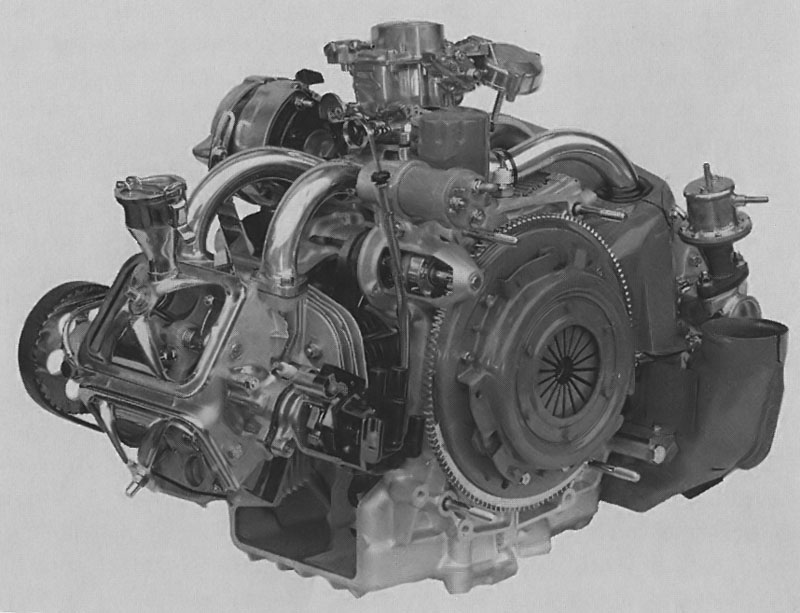 |
|||||||||||||||
|
This semi-cutaway picture of the original 1015 boxer (horizontally opposed) engine demonstrates how compact it was. Thanks to widespread use of alloys, it was also light and could be mounted forward of the drive train in A Series fashion. |
|||||||||||||||
|
From 1955 until April 1961 the range of cars comprised only two models - the utilitarian 2CV & the relatively costly D series. Spring ’61 saw the launch of the Ami 6, which edged a little more upmarket than the 2CV, but without offering the customer anything more exciting than that car's underpinnings - including an enlarged version of the twin pot. It was to fill the void that the design department initiated Projet F. The mid range was a very lucrative area in which Renault, Peugeot and Simca dominated the French market. The brief was to create not one, but an entire range of cars. At the lower end of the spectrum there would be a relatively simple model, with torsion bar suspension and a 750 cm3 flat twin derived from that of the 2CV. For the more ambitious buyer, a version with hydropneumatic suspension and a Wankel engine was envisaged. Into the middle ground was pitched an all-new flat four. A smaller, 1.6 litre transversely-mounted version of the 1.9 litre DS engine was developed which explains why, when the fundamentals of the boxer unit were laid down, it was never expected to grow beyond 1200 – 1300 cm3. The lion’s share of engineering effort was absorbed by development of the rotary engine. The job of creating both the twin and the four went to a small team assembled around Jean Dupin. He & his colleagues, including Messieurs Gautier and Foucher went on to develop two versions of the four cylinder unit, one with a capacity of 950 cm3 and the other with 1130 cm3. Bearing in mind that the company had sold a car with an air-cooled engine since 1948, this was a natural choice for the new four cylinder. Free from the complications and weight of a radiator, water pump & associated plumbing, the engine could be made compact and light. The flat four configuration is an elegant solution to many automotive engineering problems. It is, inherently well balanced; with vibratory forces at least an order of magnitude lower than an equivalent in-line four. More importantly, it has about the lowest centre of mass achievable in a mid-size car, which allows a relatively compliant ride, without compromising the handling. In April 1967, Project F was cancelled & from the ashes was born Projet G, which had as its progeny the GS and then the GSA. True to form, the budget for Projet G was minimal & as much as possible had to be carried over from its still-born predecessor. Probably the most significant legacy of Project F was Dupin’s engine. Of course, the Wankel engine finally made it into production, but only 847 GS Birotors were made and the majority were subsequently bought back & crushed by CitroŽn, anxious to avoid provision of spares backup for a tiny number of vehicles.
|
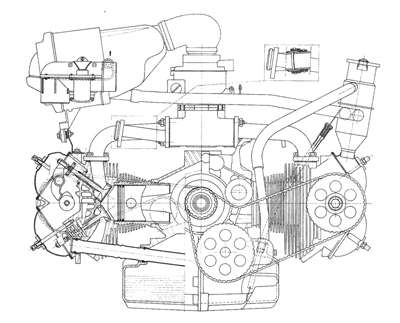 |
||||||||||||||
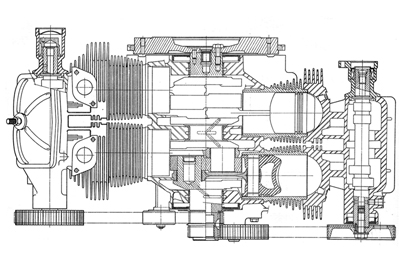 |
|||||||||||||||
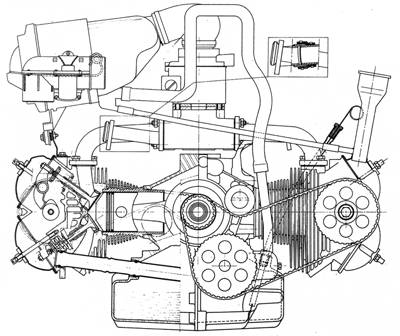 |
|||||||||||||||
|
When the brief for Projet G was agreed, it was felt that an engine of less than 1 litre would not be acceptable in the mid range market, so the 950 cm3 unit was expanded to 1015 cm3. An early priority was for smooth and quiet running so the cylinder head and combustion chamber were optimised with this in mind, even though fuel economy suffered as a result. With the mid 70s oil crisis this was addressed as can be seen in the fuel consumption figures, which steadily improved even though the engines grew in capacity. |
|||||||||||||||
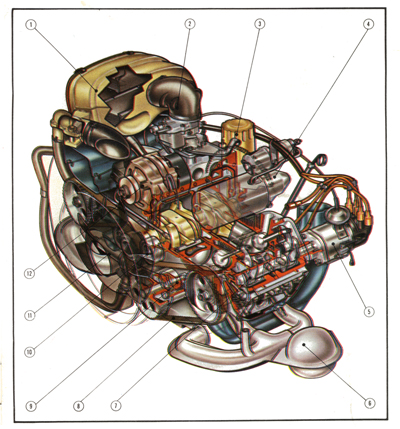 |
1015 cm32 versions., both producing 55.5 bhp DIN at 6 500 rpm and 7.2 mkg (52 ft lbs) DIN at 3500 rpm At launch, in October 1970, the carburettor hotspot was heated by engine oil, but this gave problems with slow warm-up, so a revised heating arrangement using exhaust gas was used. This lasted throughout the life of the engine, though it made one of the most complicated exhaust systems around - 12 different pipes and 9 clamps of 4 different types. Within a few months of launch, rumours started to circulate of accelerated wear to the camshafts. It turned out that all development work had been carried out using Total multigrade lubricants & lesser products did not offer the same level of protection. The anecdote, oft repeated, is that 2 brothers in the same town each had their own garage businesses. One experienced no problems with cam wear, while the other saw a number of cases. One bought his oil from Total, the other did not. Whether this is true, or a convenient explanation for CitroŽn, we will probably never know. Either way, the case hardening process was improved & the underlying problem resolved within a very short, though the reputation for premature failure took rather longer to dispel. |
||||||||||||||
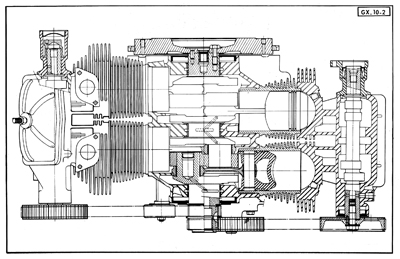 |
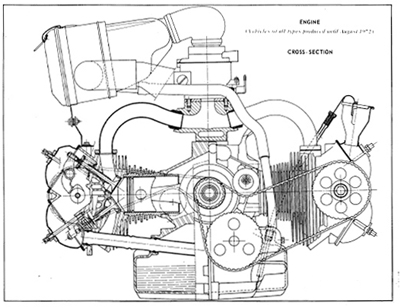 |
||||||||||||||
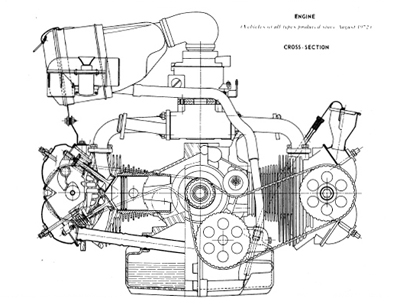 |
1220The 1220 engine was launched in September 1972 for the 1973 model year. It is quite different from its smaller predecessor. One change is the adoption of a longer stroke of 65.6 mm that would be the standard dimension for all other variants. It was produced in two different states of tune, with the “cooking” versions offering 60 bhp DIN at 5750 rpm and the units fitted to the GS X2 boosted by 7 horsepower, primarily through improved carburetion. 1129The 1015 engine was dropped from the GS range in September 1977, with the entry-level product now the 1129cc unit. This is a shrunken 1222 rather than a stretched 1015. |
||||||||||||||
1299An X denoted the sporty end of the GS range, so it is natural that the 1299 engine, should be seen first in the GS X3, launched in September 1978. In fact this was the only GS to feature this engine, as the GSA was just around the corner. The increase in capacity of 79 cc did not increase the maximum power output, though it was delivered at 5500 rather than 5750 rpm but it did offer more torque throughout the rev range. Although it was further developed into the 1981 ECO (for economy) unit, the capacity never grew beyond 1.3 litres, apparently because of concerns about cooling. The ECO engine was also fitted with electronic ignition and a larger air filter. Under the skin, the carburettor has different settings and subtle changes to both cam timing and cam follower design. The pace of change slackened thereafter, with the only notable evolution being an increase in the service interval from 7500 km to 10,000 km in July 1984. However, this seems to have been a marketing-inspired “upgrade”, as no discernible engineering changes were made. |
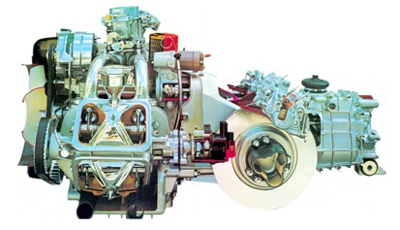 |
||||||||||||||
1301In Italy, at the time when the GSA was launched, cars had to have an engine in excess of 1.3 litres to be allowed on the Autostrada. CitroŽn therefore offered the GSA with a stated engine capacity of 1301 cc. Most remarkably, it seems that they really did produce special engines for the Italian market. Certainly there is a specific reference in the parts book to a set of pistons and barrels unique to that country - (95 577 605 for the suspicious amongst us). Had the situation been reversed, would the Italians have created a special product for a niche market in France? One suspects the difference would have been limited to the boot badge. |
|||||||||||||||
 |
|||||||||||||||
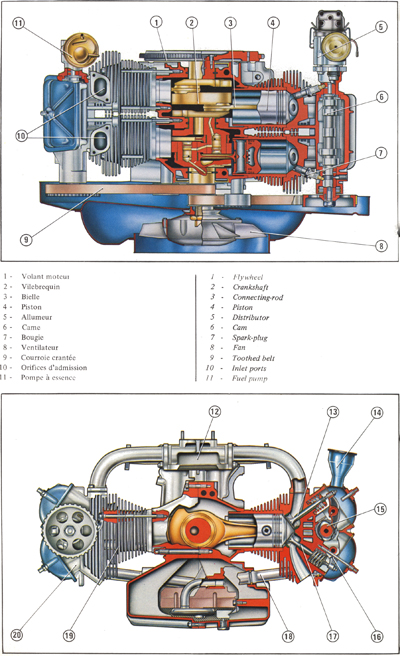 |
Other vehicles powered by the GS EngineManufacture of the GSA ceased in 1986, though a one-off deal to export 300 to Indonesia & hence clear the decks means that 1987 is sometimes quoted as the last year of production. That did not, however, mark the end of the flat 4 engine, which lived on in both 1299 & 1129 guises in the Oltcit. A Romanian built car, based on the pre-PSA design that was eventually watered down and adapted to use Peugeot components and was built as the Visa. Perhaps best explained by the substantial “book value” of the tooling used for the 1015 cm3 engine, when the majority of sales were accounted for by the 1222, the Ami Super was an Ami 8 with a flat 4 squeezed under the bonnet. Launched in May 17 1972, it was always a niche product, making up less than 2.5% of total Ami sales. It was withdrawn in February 1976. The Ami Super was only ever available with the 1015cc engine, with power reduced by 2 horsepower to 53.5 bhp because of a more restrictive exhaust layout. The MEP was a series of single seater racing cars made by Maurice Pezous, a CitroŽn dealer from Albi in the Dťpartement of Tarn, Southern France. His first experiments in the mid 60s used a flat twin from the Ami 6, but he progressed quickly to the more powerful 850 twin from a Panhard 24 CT. However, the true potential of the chassis was revealed only in 1971 when the cylinder count went up by 100%, with a 1015 GS motor. The full scope of modifications applied is not completely clear, but it is known that the compression ration was raised from 9.0 to 9.2:1 and the basic Solex carburettor was drastically upgraded to a pair of twin choke Webers (40 IDF 15s to be precise). A power output of 78 bhp at 6750 rpm was claimed, an increase of 40% over stock, giving a top speed in excess of 200 km / hr (125 mph). Twenty five of these racers were made in 1971 for a single-model series called Formule Bleu. Others The relative simplicity, small size and light weight of the flat four, not to mention relative cheapness brought on economies of scale have made it attractive to various entrepreneurs. However, their projects were not a dramatic success & none exceeded a handful of units. Aircraft The AS 37 was a two seater biplane powered by 1220 engine, which drove two propellers via toothed belts. It was the last of a series of 7 aircraft designed by a French engineer called Andre Starck & went on sale in 1976. How many were sold & whether any still exist is far from clear. Hovercraft The annual Philips prize for young people under 21 was won in 1979 by a certain Bernard Lindauer for his hovercraft, powered by a 1299 cc engine. The most significant feature was a variable speed transmission that enabled the drive to the lift propeller to be varied independently of the propulsion props. In the early 1970s the French army started looking to replace its fleet of aging Hotchkiss jeeps with a new Voiture LťgŤre, Tout Terrain (VLTT) or lightweight 4 x 4 In 1973, just before the takeover by Peugeot, CitroŽn presented the M7, built by Heuliez, featuring a 1222 GS engine. Though a tempting package, it was let down by relatively modest torque, not best suited to a cross country vehicle. The prize ultimately went to the Peugeot P4. |
||||||||||||||
|
Named after the founders of the company (Louis Boccardo, Dominique Favario & Thierry Grange), the BFG was a touring motorcycle, built around the CitroŽn flat 4 engine, in 1299 cm3 guise, at la Ravoire, near Chambťry, in SE France. Broadly standard in specification, the power unit featured cast alloy rocker covers in place of the pressed steel originals, to improve the aesthetics. Other changes include replacement of the mechanical fuel pump with an electric unit in the tank, electronic ignition and of course the twin exhausts one would expect on a two wheeler. Output power was a claimed 70 BHP at 5500 rpm (DIN), though where the additional 5 horsepower came from is not entirely clear. With a dry weight of 262 Kg, it was never going to win any prizes on the drag strip, though at least it offered reasonable cruising economy of 58 mpg at 56 mph & 46 mpg at 75 mph (for comparison, the figures are 48 & 35.3 mpg for the equivalent saloon). Production ran to some 400 units between the start of 1982 and the closure of the enterprise in December 1983. The following year, production restarted, this time in Saint Quentin under the name MBK, but manufacture ceased after a further 150 odd units left the gates. It is believed that a further dozen or so bikes were built up from spares. One simply has to mention the gorgeous Camargue, built by Bertone around a 1971 GS. This was first displayed at the Salon de Geneve in March 1972 & subsequently appeared at 2 or 3 shows in France, but though it is still believed to exist, it has not been seen in public for many years. A year later, Yves Dubernard of Heuliez presented his vision of a “GS Buggy”, a futuristic 2 door / 2 seater with doors that collapsed into the sills, BMW Z1 style, albeit 14 years earlier. |
|||||||||||||||
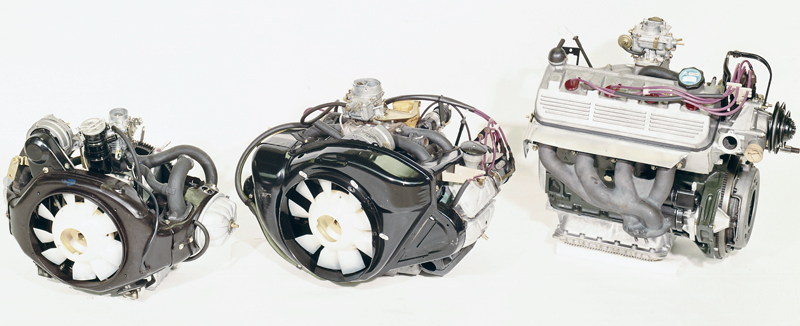 |
|||||||||||||||
|
Above from left to right 2CV flat twin, GS flat four and CX in line four Below cutaway photos from CitroŽn Presse |
|||||||||||||||
|
|||||||||||||||
|
My sincere thanks to Andrew Cox for much of the text and some of the images. Thanks also to Paul at Citroen Concours of America; Attila Kalmanczhelyi and Vladimir Vassilev. |
|||||||||||||||
| © 2005 CitroŽnŽt/CitroŽn Presse |
|||||||||||||||